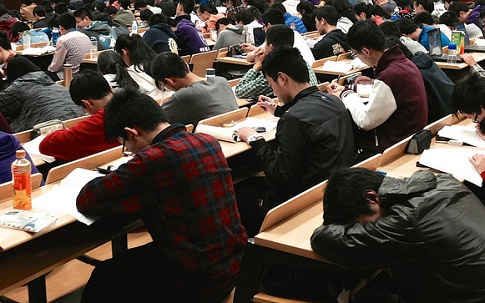A better way to teach? Professors take note.
 Subscribe to Decision Science News by Email (one email per week, easy unsubscribe)
Subscribe to Decision Science News by Email (one email per week, easy unsubscribe)
META-ANALYSIS SUGGESTS ACTIVE LEARNING BEATS LECTURING FOR TEACHING SCIENCE
With technology, old ways of doing things give way to simply better alternatives. We no longer need to pick up a phone to buy a plane ticket or hail a cab. We no longer need to carry cash around to pay for most things. Soon, students may not need to listen to traditional lectures to learn science and math because technology can make most STEM lessons participatory. But will the new model of instruction be as effective as traditional lecturing? In what its authors call “the largest and most comprehensive meta-analysis of undergraduate STEM education published to date”, the answer seems to be yes.
ABSTRACT
To test the hypothesis that lecturing maximizes learning and course performance, we metaanalyzed 225 studies that reported data on examination scores or failure rates when comparing student performance in undergraduate science, technology, engineer- ing, and mathematics (STEM) courses under traditional lecturing versus active learning. The effect sizes indicate that on average, student performance on examinations and concept inventories in- creased by 0.47 SDs under active learning ( n = 158 studies), and that the odds ratio for failing was 1.95 under traditional lecturing ( n = 67 studies). These results indicate that average examination scores improved by about 6% in active learning sections, and that students in classes with traditional lecturing were 1.5 times more likely to fail than were students in classes with active learning. Heterogeneity analyses indicated that both results hold across the STEM disciplines, that active learning increases scores on con- cept inventories more than on course examinations, and that ac- tive learning appears effective across all class sizes — although the greatest effects are in small ( n = 50) classes. Trim and fill analyses and fail-safe n calculations suggest that the results are not due to publication bias. The results also appear robust to variation in the methodological rigor of the included studies, based on the quality of controls over student quality and instructor identity. This is the largest and most comprehensive metaanalysis of undergraduate STEM education published to date. The results raise questions about the continued use of traditional lecturing as a control in research studies, and support active learning as the preferred, empirically validated teaching practice in regular classrooms.
REFERENCE
Freeman, Scott, Sarah L. Eddy, Miles McDonough, Michelle K. Smith, Nnadozie Okoroafor, Hannah Jordt, and Mary Pat Wenderoth. (2014). Active learning increases student performance in science, engineering, and mathematics, PNAS, 111 (23), 8410-8415; published ahead of print May 12, 2014, doi:10.1073/pnas.1319030111. [Download]


